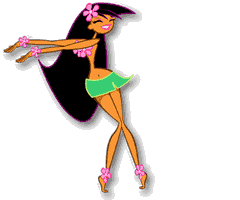The dance known as hula was developed in the Hawaiian Islands by their original Polynesian settlers, who migrated there by outrigger canoes from southeastern Pacific islands. Hawaiian people had been dancing hula for centuries. They even have a goddess of the hula, Laka. Hula was danced more by men than women in the old days, and was also a part of religion. The men and women did not wear grass skirts. They wore skirts made of kapa cloth (inner bark of the paper mulberry tree that is beaten with water and a special wooden hammer), and the men wore a malo (loincloth) which was made of the same material.
Later, when the missionaries arrived in the 1830's, they were shocked by the open dancing. This is how they described hula "The natives would practice in the hot sun for days on end. Drums pounded, gourds rattled, singers chanted, and hundreds of dancers wearing garlands of green leaves and flowers and dog-tooth anklets moved endlessly to and fro in lines, their brown skin glistening with sweat, with no sign of boredom or tiredness,"
. The missionaries convinced Queen Kaahumanu that hula was bad. It was outlawed in town, but the people out in the country still danced it. When David Kalakaua became king in 1874 he brought hula back into the city and executed the banishment. He was particularly enthusiastic about reviving the hula in all its splendor and joy. During his reign, professional hula troupes became popular again and they meandered about entertaining people at luaus, public occasions and the theater.
Hula remains traditional in Hawaii and more popular than ever. It has since grown and has extended throughout the world. From Japan to Europe and all throughout the United States. Hula is no longer known or thought of as “bad” or “wrong”, but now it is known as one of the most graceful and welcoming dances.
Now please feel free to learn the hula by clicking the links below. They are in uniform order however, you are free to explore as you please.
Mahalo Nui Loa
Have fun!!
 Resources
Resources